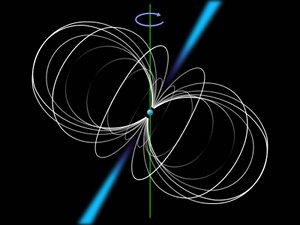WARNING: This website is obsolete! Please follow this link to get to the new Einstein@Home website!
The Einstein@Home Arecibo Radio Pulsar search: Topic 7 |
|
What can we learn about radio pulsars? |
[previous] [home] [next] |
||||
|
Since their discovery in 1967 by Jocelyn Bell and Anthony Hewish in Cambridge, UK, radio pulsars are one of the most exciting fields of astronomical research. Although there is a basic understanding of how they work, many details of the physical processes have yet to be determined. For example: how many charged particles are accelerated by the ultra-strong magnetic field? What kind of particles are they? How exactly do they move? At what distance from the neutron star's surface is the radiation created that the radio observatories detect? And more mysteries are buried below the surface: what is the interior composition of such an object? Is there a core that consists not of neutrons but of their constituents, the quarks? Our new project should help to answer these questions. Moreover, these fascinating objects are of interest not only to astrophysicists but also to nuclear and particle physicists. Astronomers will be interested in the new information regarding the population of pulsars, and hence neutron stars, as remains of supernova explosions. Is the current understanding correct or is there a surplus of either pulsars in binaries or those that were kicked out of the pairs through asymmetries in the stars' final blow ups? With this information, supernova models can be tested or refined, what, in return, tells how strong the gravitational wave emission of such an event should be and how such signals should be shaped. |
|
Last updated on 10 June 2009
This material is based upon work supported by the National Science Foundation (NSF) under Grants PHY-1104902, PHY-1104617 and PHY-1105572 and by the Max Planck Gesellschaft (MPG). Any opinions, findings, and conclusions or recommendations expressed in this material are those of the investigators and do not necessarily reflect the views of the NSF or the MPG.
Copyright © 2024 Einstein@Home

